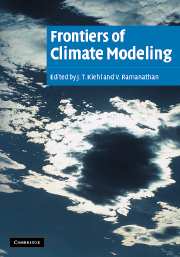Book contents
- Frontmatter
- Contents
- Preface
- List of Contributors
- Acknowledgments
- 1 Overview of climate modeling
- 2 Climate-change modeling: a brief history of the theory and recent twenty-first-century ensemble simulations
- 3 Energy-balance climate models
- 4 Intrinsic climatic variability: an essay on modes and mechanisms of oceanic and atmospheric fluid dynamics
- 5 The radiative forcing due to clouds and water vapor
- 6 A model study of the effect of Pinatubo volcanic aerosols on stratospheric temperatures
- 7 Unresolved issues in atmospheric solar absorption
- 8 Cloud feedbacks
- 9 Water-vapor feedback
- 10 Water-vapor observations
- 11 New frontiers in remote sensing of aerosols and their radiative forcing of climate
- 12 Cloud–climate feedback: lessons learned from two El Niño events
- 13 Runaway greenhouses and runaway glaciations: how stable is Earth's climate?
- Glossary
- Plate section
7 - Unresolved issues in atmospheric solar absorption
Published online by Cambridge University Press: 12 August 2009
- Frontmatter
- Contents
- Preface
- List of Contributors
- Acknowledgments
- 1 Overview of climate modeling
- 2 Climate-change modeling: a brief history of the theory and recent twenty-first-century ensemble simulations
- 3 Energy-balance climate models
- 4 Intrinsic climatic variability: an essay on modes and mechanisms of oceanic and atmospheric fluid dynamics
- 5 The radiative forcing due to clouds and water vapor
- 6 A model study of the effect of Pinatubo volcanic aerosols on stratospheric temperatures
- 7 Unresolved issues in atmospheric solar absorption
- 8 Cloud feedbacks
- 9 Water-vapor feedback
- 10 Water-vapor observations
- 11 New frontiers in remote sensing of aerosols and their radiative forcing of climate
- 12 Cloud–climate feedback: lessons learned from two El Niño events
- 13 Runaway greenhouses and runaway glaciations: how stable is Earth's climate?
- Glossary
- Plate section
Summary
Introduction
The importance of accurate estimates of solar absorption
The absorption of solar radiation by Earth's atmosphere and surface is the fundamental forcing of the climate system (Chapter 1). The net solar energy absorbed by the Earth–atmosphere system can be accurately quantified with satellite measurements of top-of-the-atmosphere (TOA) insolation and planetary albedo. These observations have determined that the net global annually-average solar radiation absorbed by the Earth is 239 W m−2 (Harrison et al., 1990; Collins et al., 1994) with an uncertainty of approximately 2 W m−2. This absorbed solar radiation can be written as the sum of the solar radiation absorbed in the atmosphere and by the planetary surface. Despite numerous investigations over the last 40 years, the partitioning of the absorption between the surface and atmosphere is still very uncertain (for reviews, see Stephens and Tsay, 1991 and Ramanathan and Vogelmann, 1997). The discrepancy between estimates from models and observational studies is known as anomalous or enhanced shortwave absorption. The enhanced absorption is usually associated with clouds, although some investigators find evidence for “anomalous” absorption in clear-sky regions (Li et al., 1995; Li and Moreau, 1996; Arking, 1996; Kato et al., 1997).
The issues of the existence and magnitude of enhanced solar absorption has been examined intensively since Ramanathan et al. (1995), Cess et al. (1995), and Pilewskie and Valero (1995) found evidence for the anomaly in the tropical Pacific. Cess et al. (1995) also found evidence for enhanced absorption at Barrow, Alaska; Boulder, Colorado; Cape Grim, Tasmania; and Wisconsin.
- Type
- Chapter
- Information
- Frontiers of Climate Modeling , pp. 179 - 216Publisher: Cambridge University PressPrint publication year: 2006
- 1
- Cited by



